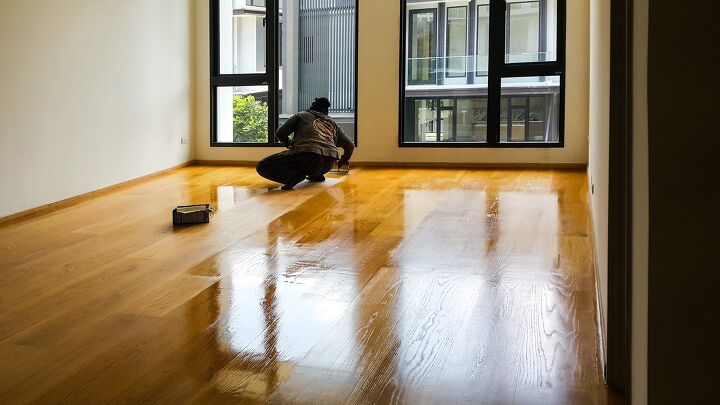Polycrylic Vs. Polyurethane

Choosing the right finish can ultimately determine how good a particular surface looks. A finish can make floors, cabinets, and crafts look better than before, but only if you choose the right one. So, what is the difference between polycrylic and polyurethane?
Polycrylic contains a water base and polyurethane is made with an oil base. Polyurethane is more durable than polycrylic, but it is sensitive to extreme temperatures and humidity.
You get a glossier finish with polycrylic and it’s easier to use, but it also takes longer to fully cure than polyurethane.
The right finish for the job depends on the project. For example, polyurethane is best for floors, whereas polycrylic is best for furniture. Follow along as we explore the difference between polycrylic and polyurethane and see which finish is best for different applications.
Is Polycrylic The Same As Polyurethane?
Polycrylic and polyurethane are quite similar, but they don’t share the same base. Traditionally, polyurethane is made of an oil base that gives the finish its durability. Polycrylic works similarly but it features a water base.
You can also find water-based polyurethane, but it’s not as popular as standard polyurethane or polycrylic. Many homeowners consider polycrylic easier to work with than polyurethane. However, that comes at the cost of a longer cure time, which is a major downside of polycrylic.
Polyurethane is known for its distinct and foul odor, but that’s not a problem with polycrylic. Both finishes are frequently used for projects such as finishing floors, cabinets, furniture, and crafts. While they aren’t the same, many homeowners place them in the same category and think of them interchangeably.
Which Is Better, Polycrylic Or Polyurethane?
Both polycrylic and polyurethane are useful around the house, but they are each ideal for different applications. Polyurethane is highly regarded for its visually appealing finish. It is also durable for foot traffic and on floors, which is essential for any finish.
The main downside of polyurethane is that it cannot withstand extreme temperature changes very well. It is also vulnerable to solvents and humidity, which can potentially strip the polyurethane. Polyurethane also carries some risks as it is flammable. You have to worry about scratches much more with polycrylic than with polyurethane.
Polycrylic doesn’t smell nearly quite as strong as polyurethane. While polycrylic is durable, it is even more sensitive to humidity and temperature changes than polyurethane. Polycrylic is easier to work with than polyurethane, however, and it is better for indoor use. Choosing between polycrylic and polyurethane ultimately depends on the project.
Over Paint
You can use both polycrylic and polyurethane over paint. However, the right one for you depends on the color of the paint that you are trying to brush over. For example, you wouldn’t want to apply polyurethane over a coat of light paint.
That would discolor it and it would eventually turn yellow. In that case, you should use polycrylic instead to avoid unpleasant discoloration. Only apply polycrylic to oil-based paint or it won’t adhere well and won’t look as glossy as it could.
Crafts
Choosing between polycrylic and polyurethane for crafts depends on what project you are working on. Polyurethane can offer more protection, but polycrylic provides a glossier, cleaner appearance. It’s worthwhile to use polyurethane rather than polycrylic for most crafts unless you work with light wood.
It can be slightly easier to work with polycrylic, but polyurethane cures faster, which comes in handy when working with crafts. Be careful to make sure that your brush strokes are even before either polycrylic or polyurethane dries. The last thing that you want to do is re-finish your craft because of inconsistent brush strokes.
Kitchen Cabinets
Refrain from using polyurethane on kitchen cabinets that are light in color. It can sometimes leave a yellow sheen behind that is only noticeable on light cabinets. However, polyurethane is perfect for tan and dark cabinets.
Otherwise, polycrylic is the best option for light cabinets because you don’t have to worry about discoloring them. Polycrylic isn’t a great option if your cabinets are directly above the stove. The heat from the stove may weaken and ruin the polycrylic over time.
Be careful if you finish a cabinet with polycrylic because of its runny consistency. Ideally, you should apply small amounts of polycrylic at a time when working with a vertical surface. That way, it won’t run and create an uneven finish on your cabinets.
Floors
Polyurethane is better for floors than polycrylic. Standard polyurethane has an oil base that can easily hold up to heavy foot traffic. Scratches will still damage the polyurethane, but you won’t have to worry about furniture and feet.
Simply apply another coat of polyurethane to your floors if they scratch. You can use polycrylic for floors, but the finish takes so long to cure that it can be quite inconvenient. Polycrylic is the best option to finish light floors.
Table Top
Polycrylic is the perfect finish for table tops. Many homeowners consider polycrylic to be better than polyurethane when it comes to finishing table tops and other furniture. It’s easy to work with and looks great as long as you can be patient during the 24-hour curing period.
However, it ultimately depends on how you want your table to look. Polycrylic can help achieve a nice glossy finish, but that isn’t ideal for everyone. Consider an oil-based polyurethane if you don’t want your table to look too shiny.
Is Water-Based Polyurethane Better Than Polycrylic?
Water-based polyurethane is better than polycrylic in terms of durability, but not necessarily style. It isn’t quite as strong as oil-based polyurethane, but water-based polyurethane offers similar durability.
However, it comes with the same downsides as oil-based polyurethane, such as susceptibility to moisture and heat.
Polycrylic is safer to use than water-based polyurethane, however. Even water-based polyurethane is flammable and can release harmful fumes. The smell of water-based polyurethane can last for days or even weeks in some cases.
That isn’t a problem with polycrylic, although it is still somewhat flammable. It is recommended that you use polycrylic over polyurethane if you have asthma or similar respiratory problems.
Granted, you don’t have to worry about fumes once water-based polyurethane dries, but it can be frustrating and dangerous until then.
Does Polycrylic Need To Be Sanded?
Polycrylic doesn’t need to be sanded, but you may need to sand the surface before applying it. An uneven surface can make it nearly impossible for polycrylic to sit evenly. This can result in streaks that look bad and weaken the integrity of your finish.
Be careful if you sand a painted surface so that you don’t strip the paint. Use 220-grit sandpaper and sand the surface by hand so that you don’t damage it. You may not need to sand the surface if it isn’t bumpy and uneven.
Can You Apply Too Many Coats Of Polycrylic?
You can put on too many coats of polycrylic and it will negatively affect the finish. Typically, three coats of polycrylic are suitable for cabinets, floors, and furniture. You can apply more than three coats of polycrylic, but each additional coat could jeopardize the finish.
Too many coats of polycrylic can make the finish look cloudy. This defeats the purpose of a glossy finish, so it’s not worthwhile to add too many coats of polycrylic. That is especially true if you are finishing dark floors or cabinets.
Inspect the surface roughly 3-4 hours after you apply the third coat. Add one more coat if you think the surface needs the extra polycrylic, then let it sit for 24 hours to cure. After it cures, you should be able to tell whether or not one more coat is necessary. It’s unlikely that you’ll need to apply another coat of polycrylic, but it’s worth waiting just to play it safe.
Summing It Up
Polyurethane is more durable than polycrylic, but polycrylic has a glossier finish. Use polyurethane for floors unless they are too light. Unfortunately, polyurethane can leave behind a strange yellow stain that only shows on light surfaces.
Polycrylic is unsuitable in many cases for floors that hold lots of furniture. That is because polycrylic is more susceptible to scratches than polyurethane. Once a surface is scratched, you will need to refinish it all to make it even. Both options are great, but polyurethane is your best bet if you are looking for durability.
Related Guides

Nick Durante is a professional writer with a primary focus on home improvement. When he is not writing about home improvement or taking on projects around the house, he likes to read and create art. He is always looking towards the newest trends in home improvement.
More by Nick Durante











![The 10 Best Table Saws - [2022 Reviews & Buyer's Guide]](https://cdn-fastly.upgradedhome.com/media/2023/07/31/9070645/the-10-best-table-saws-2022-reviews-buyer-s-guide.jpg?size=350x220)
![The 5 Best Angle Grinders – [2022 Reviews & Buyer's Guide]](https://cdn-fastly.upgradedhome.com/media/2023/07/31/9071326/the-5-best-angle-grinders-2022-reviews-buyer-s-guide.jpg?size=350x220)














